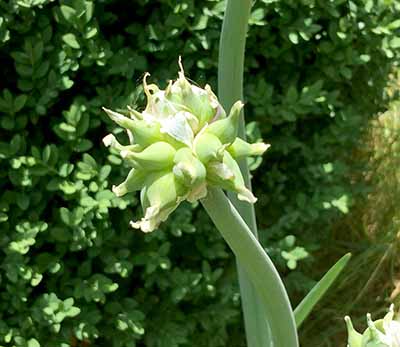Egyptian walking onions – what are these strange-looking plants?
Egyptian walking onions are not from Egypt and they don’t walk, but they are onions!

This is the curious tale of the Egyptian walking onion, a plant with many names and stories attached. Most of the stories are entertaining, but not necessarily correct. The Egyptian walking onion, or Allium X proliferum, has been identified as a hybrid of the Welsh onion. This onion has been in the U.S. since about 1850 and was brought from Europe. It is originally from the Indian subcontinent and was moved by people settling in new locations who wanted to take some hardy onions from home to their new homes.
Other names for this unusual onion that produces small onions at the top of the stems are tree onions, top onions, top-set onions, winter onions and perennial onions. Regardless of its name, it is hardy to zone 3 and stays green all winter. It is like garlic in that little bulblets or bulbils form at the top of the stems. The walking onions can be removed and planted or eaten. The Egyptian walking onion produces more bulblets than other alliums and more can form additional stems above existing bulblets to form a second layer of bulblets, giving the plant a crazy Medusa onion hairdo.
 The walking portion of its name comes from the large stems that support the clusters of bulblets. When the bulblets mature, the stem begins to dry out and weaken, and the stem with mature or almost mature bulblets topples over. It falls the distance of the stem from the parent plant. This is as far as these onions can walk. The little onions have tiny root nubs and small green leaf blades, and those that hit the ground “right-side up” grow. You can also pick the onions, separate them and plant them where you choose. The bigger the bulblet, the better the growth.
The walking portion of its name comes from the large stems that support the clusters of bulblets. When the bulblets mature, the stem begins to dry out and weaken, and the stem with mature or almost mature bulblets topples over. It falls the distance of the stem from the parent plant. This is as far as these onions can walk. The little onions have tiny root nubs and small green leaf blades, and those that hit the ground “right-side up” grow. You can also pick the onions, separate them and plant them where you choose. The bigger the bulblet, the better the growth.
Egyptian walking onions grow in full sun and prefer loamy sand or sandy loam soil. Just like all onions, they do not grow in wet or extremely heavy soils. A soil pH in the vicinity of 6.5 makes for happy onions.
The bulblets of the Egyptian walking onion can be eaten raw or cooked. They can be pickled or sliced into salads. The smaller onion blades on the plant can be used like chives, but the bulb of the parent plant is tough-skinned and pungent. Michigan State University Extension recommends you save mama onion for more baby bulblets.



 Print
Print Email
Email